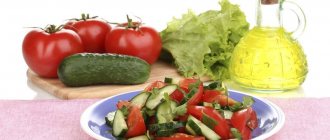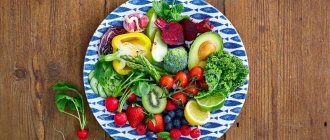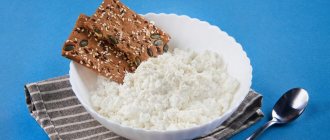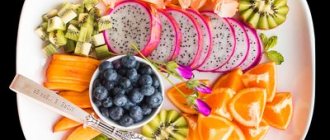In order to have a slim figure and a healthy appearance, you do not need to starve yourself. If you follow a balanced diet, your figure will gradually return to normal.
You can lose weight with pleasure and taste.
Strict diets give quick and short-lived results; they often affect various systems of the body, disrupting their functioning. A balanced diet, on the contrary, improves your health and gives positive results for many years.
Drinks in a balanced diet
One of the main tenets of a healthy diet is to drink enough liquid, namely, clean drinking water. If you drink a lot of tea or coffee, reduce the amount, these drinks dehydrate the body. For every cup of coffee you need to drink two cups of water.
Juices, sweet compotes, carbonated drinks should not be included in a balanced diet. You can drink compote or herbal teas without sugar; instead of juice, it is better to eat a regular fruit or vegetable - it contains all the same vitamins, less sugar, and also valuable plant fiber.
Healthy drinks include coconut water - it is low-calorie, has a rich composition, noni juice - it is more of a vitamin supplement than a drink, and carob - a cocoa substitute.
To quench your thirst, it is better to drink plain water. It ensures the normal functioning of all body systems, helps to be alert, and preserves the beauty of the skin.
Basic rules for a balanced diet
When calculating the caloric content of a diet for a week and a month, many factors must be taken into account - gender, age, a person’s lifestyle, whether he wants to lose weight, build muscle mass, etc.
Rules:
- Power mode and frequency. Divide your diet into 5 meals, 3 main meals and two snacks. This will help maintain your metabolism and not go hungry during the day.
- Always have a healthy snack on hand. It’s bad to take long breaks between meals and suffer from hunger; it’s no better to snack on anything.
- BZHU. In addition to caloric content, the ratio of proteins, fats and carbohydrates, vitamin and mineral value of food is important.
- Diversity. Any product becomes boring if you eat it every day. Even on a low-calorie diet, it’s easy to make your diet varied - cook new dishes every day, experiment with spices.
- A smart approach. There is no need to go to extremes - if you really want a piece of unhealthy cake, eat it. Only one. You can fit it into your daily calorie intake. Metabolism, accustomed to a balanced diet, will cope with a one-time load without harm to your figure and health.
Recommendations for proper nutrition
Attention! All recommendations and dishes given in the article are designed for a healthy person who does not require a special diet.
- Contrary to what some people think, proper nutrition is not boring and bland. You need to eat fruits and vegetables, preferably fresh and seasonal, although today you can find high-quality cucumbers and tomatoes even in winter.
- Meat is important, preferably lean, poultry, fish (especially sea). For vegetarians, the source of protein will be legumes, soybeans, nuts, and some vegetables (asparagus and spinach). You can eat bread - but instead of white flour, it should be made from rye, whole grain, or buckwheat flour. The same goes for pasta.
- Food can be boiled, stewed, baked, grilled or dry-fried. The less heat treatment, the more useful substances remain in the food, but meat and fish must be boiled/baked until cooked, especially if children will eat them.
- It is better to avoid refined sugar and replace it with honey, dates, and fruits. You can also get healthy carbohydrates from cereals - eat porridge as a separate dish and as a side dish.
- The body needs fats - in moderation. Don’t give up quality cheeses, butter, and a variety of vegetables. Corn, flaxseed, and sesame oil in salads are healthier and tastier than traditional sunflower oil.
Completely eliminate smoked foods, processed foods, margarine, sweet dairy products, and carbonated drinks from your diet.
Grocery list
You can download the entire list of products at once into your cart by clicking on the link, and forget about shopping and shopping planning for these days.
Or you can download each recipe individually. One caveat: the ingredients in the recipes overlap, because we tried to optimize the set so that the ingredients and prepared dishes would be enough for several times. But in any case, you can adjust the required quantity in the basket.
If some products are not available at your address, they will be in the basket with a gray picture - do not forget to select replacements for them. We recommend choosing the “Delivery for tomorrow” option and placing your order before 13-00 - then you will be able to choose products from the widest possible range.
Let's assume that you already have vegetable oil, salt and your favorite spices at home. If not, be sure to add them to your cart!
Our main task is to cook tasty, healthy and as simple as possible. Go!
How to create a balanced menu for the week?
First of all, you need to determine the calorie content of your menu using special calculators, there are many of them on the Internet. The system takes into account gender, weight, age and degree of mobility. If you want to lose weight, subtract 300-500 calories.
- Each person has his own individual characteristics that the calculator cannot take into account. If you don’t have any particular problems with losing weight, it’s enough to compare your menu a couple of times with the expected calorie intake; you shouldn’t get hung up on the numbers.
- More important is the quality of the diet, or the balance of proteins, fats and carbohydrates. On average, for a healthy adult it should be 1:1:4. If the goal is to gain muscle mass, and a person plays a lot of sports, you need to reduce the amount of fat and increase the amount of protein.
- Using special calculators and applications for your computer and even your phone, you can calculate the composition and calorie content of each dish, and then your daily diet. Combined with knowledge of the basic principles of a balanced diet, this will help you create a healthy menu for the week.
- In your personal menu, you can specify the times for breakfast, lunch and dinner. It is better to always eat at the same time - the regime improves digestion. Between them you can add an afternoon snack and a small snack - nuts, fruits, a glass of kefir will help you last until lunch or dinner and not overeat.
Balanced menu for the week
Below are menu options for 7 days for different people. They are all exemplary and help to understand the principle by which proper nutrition is built. You can replace dishes and add new ones to suit your taste.
Menu for children
This menu is for a 4-year-old child (if he does not go to kindergarten). Portion sizes are approximate; the appetite and body composition of a particular child should be taken into account.
Fruits or dried fruits as a snack should be given an hour before the main meal, and not after, otherwise they can cause fermentation in the stomach (this also applies to adults). Before going to bed any day you can drink kefir or fermented baked milk.
| Day of the week | Menu |
| Monday | Breakfast: buckwheat porridge, whole grain bread, cheese, tea or cocoa. Dinner: fresh cabbage soup with a spoon of sour cream, chicken, zucchini and carrot stew, compote, 1-2 slices of bread. Afternoon snack: 5% fat cottage cheese with pear and banana. Dinner: rice with steamed fish cutlet, bread, chamomile tea. |
| Tuesday | Breakfast: steam omelette, sandwich of white bread with butter and cheese, tea. Dinner: puree pumpkin soup, pasta with mixed minced meat, 1-2 slices of bread, compote. Afternoon snack: bun or cookie, fermented baked milk. Dinner: mashed potatoes and cauliflower, steamed chicken breast, rosehip drink. |
| Wednesday | Breakfast: baked cheesecakes with sour cream, cocoa. Dinner: borscht with pieces of meat, fresh cabbage salad, 2 slices of bread, compote. Afternoon snack: assorted apples, pears, bananas, sugar-free yogurt. Dinner: polenta, chicken cutlet, herbal tea. |
| Thursday | Breakfast: oatmeal with banana and cinnamon, cocoa, sandwich with cheese. Dinner: creamy potato soup, steamed hake fillet, Chinese cabbage salad, bread, tea or compote. Afternoon snack: 2 pancakes with curd filling, compote. Dinner: stewed cabbage with chicken, tea. |
| Friday | Breakfast: milk rice porridge with raspberries, sandwich with cheese, tea. Dinner: noodle and chicken soup, ratatouille, bread, compote. Afternoon snack: cottage cheese with assorted berries. Dinner: pilaf with dried fruits, fresh cabbage salad, tea. |
| Saturday | Breakfast: pancakes with honey, tea. Dinner: pureed cauliflower and potato soup, steamed meatballs, tomato and herb salad, bread. Afternoon snack: assorted fruits, fermented baked milk. Dinner: homemade pizza with chicken, mozzarella and vegetables, tea. |
| Sunday | Breakfast: buckwheat porridge, boiled egg, whole grain bread with butter. Dinner: green borscht, vinaigrette, steamed chicken fillet, bread, tea. Afternoon snack: bun with fermented baked milk or compote. Dinner: fish cutlets with pasta, tea or compote. |
Menu for women
The example is designed for a woman 20-30 years old.
After 35, metabolism tends to slow down. Nutritionists recommend reducing caloric intake and increasing physical activity to avoid weight gain.
You can also snack on nuts, apples, bread, and drink a glass of low-fat fermented milk product in the evening.
| Day of the week | Menu |
| Monday | Breakfast: oatmeal in water with fruit, coffee or tea. Dinner: pumpkin puree soup, whole grain bread. Afternoon snack: cottage cheese with dates. Dinner: brown rice with chicken and Hawaiian mixture (carrots, peas, corn), tea. |
| Tuesday | Breakfast: boiled eggs, bread with cream cheese, coffee or tea. Dinner: salmon steak with boiled potatoes, Chinese cabbage salad. Afternoon snack: Greek yogurt with berries. Dinner: vinaigrette with beans. |
| Wednesday | Breakfast: buckwheat porridge, cheese, tea or coffee. Dinner: chicken and cottage cheese cutlets, side dish of stewed vegetables. Afternoon snack: cottage cheese casserole with honey. Dinner: vegetable salad with shrimp and avocado, bread. |
| Thursday | Breakfast: cornmeal pancakes with berries, tea or coffee. Dinner: fresh vegetable salad, baked mackerel. Afternoon snack: fermented baked milk, banana. Dinner: chicken breast with Greek salad, tea with thyme. |
| Friday | Breakfast: oatmeal with raspberries and strawberries, coffee or tea. Dinner: sea bream baked with lemon and spices, quinoa, fresh cucumbers. Afternoon snack: dessert of cottage cheese and fruits whipped in a blender. Dinner: chili bean stew, mint tea. |
| Saturday | Breakfast: cheesecakes with honey, tea or coffee. Dinner: pickle with sour cream, a slice of baked roast beef, whole grain bread or crispbread. Afternoon snack: assorted fruit, fermented baked milk or yogurt without sugar. Dinner: salad of tomatoes, chicken fillet and feta with basil. |
| Sunday | Breakfast: scrambled eggs with broccoli, whole grain bread, coffee or tea. Dinner: chicken with pearl barley and sweet pepper, fresh vegetables. Afternoon snack: pancakes with cottage cheese and berries, tea. Dinner: Vitamin salad, rice cakes, tea. |
Menu for men
A balanced diet is not tied to gender and the menu can be the same. Men require more calories if they are actively involved in sports - more protein foods.
For lunch, men should not immediately eat thick soup, meat, side dish and compote with a bun - this overloads the stomach. It is better to add 1-2 snacks to your daily diet.
To avoid problems with men's health, experts recommend consuming foods containing folic acid, zinc, selenium, vitamins B, C and E. These include fatty sea fish, nuts, seeds, seafood, broccoli, spinach.
| Day of the week | Menu |
| Monday | Breakfast: oatmeal with butter, scrambled eggs, coffee or tea. Dinner: cabbage rolls with sour cream, whole grain bread. Afternoon snack: low-fat cereal cookies, berries, compote. Dinner: baked hake with carrots and zucchini, brown rice. |
| Tuesday | Breakfast: steam omelette, bread with avocado and cottage cheese, coffee or tea. Dinner: chicken liver beef stroganoff, buckwheat porridge, vegetable salad. Afternoon snack: cottage cheese with almonds and banana. Dinner: baked chicken with root vegetables, bread. |
| Wednesday | Breakfast: polenta with cheese, coffee or tea. Dinner: broth with herbs and pasta, chicken fillet, fresh vegetables, bread. Afternoon snack: fruit, fermented baked milk or Greek yogurt. Dinner: beef patties, tomato and basil salad, bread. |
| Thursday | Breakfast: pancakes with curd filling, tea or coffee. Dinner: baked mackerel, mashed potatoes and broccoli, bread, tea. Afternoon snack: cottage cheese casserole with jam or berries. Dinner: White chili chicken and beans, tea. |
| Friday | Breakfast: oatmeal with butter and fruit, bread with cheese, coffee or tea. Dinner: chicken muffins with vegetables, cabbage soup, bread. Afternoon snack: cottage cheese with honey and nuts. Dinner: chicken breasts stuffed with pesto, fresh tomatoes, bread. |
| Saturday | Breakfast: frittata with potatoes and spinach, bread, tea or coffee. Dinner: goulash with pasta, Chinese cabbage and corn salad. Afternoon snack: pancakes with cottage cheese, tea. Dinner: chicken breasts stuffed with pesto, fresh tomatoes, bread. |
| Sunday | Breakfast: cheesecakes with jam, coffee or tea. Dinner: red borscht with meat, bread. Afternoon snack: homemade pizza with chicken, bell peppers, tomatoes and mozzarella. Dinner: vegetable salad with tuna and eggs, tea. |
Menu for the whole family
Can be similar to any of the above, only the portion size changes. In a family menu, it is important to take into account the tastes of each person and follow the general principles of healthy eating.
| Day of the week | Menu |
| Monday | Breakfast: oatmeal with butter, sandwiches with cheese, tea. Dinner: broccoli soup, chicken cutlets, brown rice, whole grain bread. Afternoon snack: cottage cheese with fruit, cocoa. Dinner: baked fish, vegetable and potato stew. |
| Tuesday | Breakfast: scrambled eggs with tomatoes and corn, bread, tea. Dinner: macaroni, cheese and chicken casserole, compote. Afternoon snack: fermented baked milk, whole grain buns. Dinner: stewed cabbage with mixed minced meat. |
| Wednesday | Breakfast: buckwheat porridge with butter, cheese, tea. Dinner: meatballs with mashed potatoes, fresh vegetables, bread. Afternoon snack: cottage cheese casserole with honey. Dinner: cauliflower in cream sauce, compote. |
| Thursday | Breakfast: cheesecakes, sandwiches with butter, chicory drink. Dinner: chicken soup with spinach, baked breasts, fresh vegetables. Afternoon snack: bread with avocado and cream cheese, herbal tea. Dinner: baked mackerel with vegetable salad, bread, compote. |
| Friday | Breakfast: oatmeal with fruit, bread, cheese, tea. Dinner: chicken liver with buckwheat porridge, fresh vegetable salad, bread. Afternoon snack: cottage cheese with fruit. Dinner: baked beef with pumpkin and Provençal herbs, tea. |
| Saturday | Breakfast: pancakes with berries or sour cream, tea. Dinner: chicken fillet rolls with cheese, brown rice, fresh vegetable salad. Afternoon snack: yogurt jelly, berries. Dinner: vegetable stew with beef, bread, tea. |
| Sunday | Breakfast: homemade burgers made from double buns, tea or cocoa. Dinner: green borscht with sour cream, fish cutlets, vegetable salad, bread. Afternoon snack: cottage cheese casserole with banana and cinnamon. Dinner: vinaigrette, steamed chicken meatballs, bread. |
Menu for schoolchildren
A school-age child spends a lot of energy on growth and learning; he needs constant energy replenishment of his body and brain. The menu shown does not include school lunches. If your child eats in the cafeteria, adjust his diet depending on the amount of food he receives outside the home.
Sample menu for schoolchildren and teenagers:
| Day of the week | Menu |
| Monday | Breakfast: milk rice porridge with raisins, sandwich with cheese, tea. Dinner: fresh cabbage soup, salad with vegetables and chicken, whole grain bread. Afternoon snack: cottage cheese with fruit. Dinner: baked fish, mashed potatoes and pumpkin, herbal tea. |
| Tuesday | Breakfast: steamed omelette, sandwich with butter and cheese, chicory drink with milk. Dinner: mixed minced meat cutlets, pearl barley with peas and sweet peppers, compote. Afternoon snack: kefir smoothie with fruit. Dinner: chicken breasts, fried without oil, fresh vegetable salad, herbal tea. |
| Wednesday | Breakfast: oatmeal with banana and cinnamon, tea. Dinner: rassolnik soup, boiled beef, fresh vegetables, bread. Afternoon snack: cottage cheese casserole with jam. Dinner: broccoli and cauliflower casserole with cheese, bread, herbal tea. |
| Thursday | Breakfast: cheesecakes with sour cream, sandwich with cheese, cocoa. Dinner: fish balls, pasta, vegetable salad, tea. Afternoon snack: rye pancakes, compote. Dinner: vinaigrette with beans. |
| Friday | Breakfast: buckwheat porridge with butter, boiled egg, bread, tea. Dinner: chicken noodle soup, meat pies, tea. Afternoon snack: cottage cheese with fruits or berries. Dinner: vegetable stew with beef. |
| Saturday | Breakfast: sandwiches with chicken fillet, cheese and herbs, chicory drink. Dinner: borscht with sour cream, baked chicken fillet, bread. Afternoon snack: semolina pudding with berries. Dinner: cabbage rolls, bread, herbal tea. |
| Sunday | Breakfast: oatmeal with fruit, cocoa. Dinner: baked mackerel, brown rice, fresh vegetable salad. Afternoon snack: fermented baked milk, biscuits. Dinner: chicken breasts, vegetable salad, cheese, tea. |
For athletes
A menu for a person actively involved in sports is not a low-calorie diet. The diet should provide a sufficient amount of energy and “building material” for muscle growth.
Sample menu for athletes in the table:
| Day of the week | Menu |
| Monday | Breakfast: oatmeal with water and nuts, low-fat cheese, coffee or tea. Dinner: steamed chicken breast cutlets, buckwheat porridge, fresh vegetables. Afternoon snack: cottage cheese 5% fat, tea. Dinner: baked lean fish with stewed vegetables, kefir or fermented baked milk. |
| Tuesday | Breakfast: steamed omelette, bread, tea or coffee. Dinner: baked turkey with brown rice, fresh vegetable salad. Afternoon snack: kefir, apples. Dinner: boiled veal, fresh vegetable salad with yogurt dressing. |
| Wednesday | Breakfast: cottage cheese with fruit, bread, tea or coffee. Dinner: seafood with pearl barley, green salad. Afternoon snack: bread with avocado and cottage cheese, tea. Dinner: salad of chicken, vegetables and eggs. |
| Thursday | Breakfast: oat pancake with cheese and herbs, coffee or tea. Dinner: baked beef, buckwheat, fresh vegetable salad. Afternoon snack: cottage cheese with fermented baked milk. Dinner: steamed fish cutlets, fresh vegetable salad with avocado. |
| Friday | Breakfast: sandwich made from whole grain bread with chicken and vegetables, some or tea. Dinner: cauliflower and chicken casserole, fresh vegetables, tea. Afternoon snack: low-fat yogurt with fruit. Dinner: vegetable stew with beef, herbal tea. |
| Saturday | Breakfast: buckwheat porridge with water, boiled eggs, coffee or tea. Dinner: chicken broth, bread, boiled breasts with fresh vegetables. Afternoon snack: cottage cheese with apples and cinnamon. Dinner: baked lean fish, vegetable salad. |
| Sunday | Breakfast: unsweetened cheesecakes with herbs, coffee or tea. Dinner: turkey breast with buckwheat, fresh vegetable salad. Afternoon snack: bread with fruit and cottage cheese, tea. Dinner: salad of chicken liver, eggs and fresh vegetables. |
For the vegan bodybuilder
In this case, the main thing in food is to gain the right amount of protein necessary for muscle growth. It can be obtained from plant products - beans, lentils, chickpeas, quinoa, broccoli, asparagus, spinach. Soy protein has been proposed as an additional source.
A vegan menu allows you to cleanse your body.
Approximate vegetarian ready-made menu for the week:
| Day of the week | Menu |
| Monday | Breakfast: oatmeal with coconut milk and nuts, coffee or tea. Dinner: fresh vegetable salad, carrot cutlets with quinoa. Afternoon snack: soy protein, fruit. Dinner: stewed beans with broccoli. |
| Tuesday | Breakfast: fruit salad, whole grain bread, coffee or tea. Dinner: vegetable soup, chickpea cutlets, green salad. Afternoon snack: a bar of nuts and dried fruits. Dinner: lentils with vegetables, tea. |
| Wednesday | Breakfast: green buckwheat porridge, banana, tea or coffee. Dinner: fresh vegetable salad, brown rice with eggplant and mushrooms. Afternoon snack: soy protein, apple. Dinner: chickpea salad with tomatoes and herbs. |
| Thursday | Breakfast: oatmeal with berries, coffee or tea. Dinner: bean soup, cabbage cutlets. Afternoon snack: fruit salad with nuts. Dinner: vegetable stew. |
| Friday | Breakfast: sandwich made from whole grain bread with tofu and vegetables, coffee or tea. Dinner: pea balls, quinoa, fresh vegetable salad. Afternoon snack: soy protein, berries. Dinner: stewed lentils with onions, carrots and herbs. |
| Saturday | Breakfast: fruit salad, lean rye pancakes, coffee or tea. Dinner: vegetable borscht, chickpea cutlets. Afternoon snack: tofu bread, tea. Dinner: brown rice with pumpkin and Provençal herbs. |
| Sunday | Breakfast: oatmeal with nuts, coffee or tea. Dinner: Broccoli puree soup, stewed beans with tomatoes and carrots. Afternoon snack: soy protein, apples. Dinner: fresh vegetable salad, lentil cutlets. |
Weekly menu for pregnant women
Don't eat for two during pregnancy, as grandmothers recommend, and you won't have to lose weight after giving birth. The main thing in a pregnant woman’s diet is balance and good quality food. You only need to slightly increase the calorie content of the menu at the end of the second trimester.
Avoid salted and dried meats and uncooked fish. During pregnancy, you should not experiment with unusual foods, but you should not limit yourself too much. Pregnancy is not a disease, and in the absence of doctor’s testimony, a pregnant woman can lead a normal healthy lifestyle.
| Day of the week | Menu |
| Monday | Breakfast: cheesecakes with banana, tea or chicory drink. Dinner: fresh vegetable salad, pumpkin puree soup, a piece of boiled chicken breast. Afternoon snack: smoothie of fruit and sugar-free yogurt. Dinner: baked dorado with lemon, brown rice. |
| Tuesday | Breakfast: oatmeal with fruit, chicory, tea. Dinner: fresh cabbage soup, pasta casserole with cheese and egg. Afternoon snack: grain cottage cheese with cream 10%. Dinner: chicken fillet with broccoli, tea. |
| Wednesday | Breakfast: omelet with tomatoes, corn and herbs, bread, chicory, tea. Dinner: salad of tomatoes and cucumbers, chicken liver with buckwheat. Afternoon snack: fermented baked milk, whole grain bun. Dinner: cottage cheese casserole, herbal tea. |
| Thursday | Breakfast: oatmeal with milk and butter, bread with cheese, chicory, tea. Dinner: chicken breast cutlets, rice with broccoli and sweet pepper, green salad. Afternoon snack: cottage cheese with fruit. Dinner: vegetable stew with lentils. |
| Friday | Breakfast: bread with curd cheese, egg, tomatoes and herbs, chicory, tea. Dinner: chicken broth with croutons, fresh vegetable salad, baked fish. Afternoon snack: yogurt without sugar, cereal cookies. Dinner: stuffed peppers, bread, herbal tea. |
| Saturday | Breakfast: oatmeal with fruits and nuts, tea, chicory. Dinner: stewed cabbage with sour cream, boiled beef, tomatoes and cucumbers. Afternoon snack: pancakes with cottage cheese, tea. Dinner: Caesar salad with chicken. |
| Sunday | Breakfast: pancakes with sour cream or honey, chicory, tea. Dinner: lean borscht with sour cream, fish cutlets, green salad. Afternoon snack: cottage cheese casserole. Dinner: zucchini pancakes, bread, tea. |
Omelette with vegetables
According to those who prepared this dish, this protein-packed, well-balanced breakfast is distinguished not only by its pleasant taste, but also by its attractive appearance. Therefore, even little picky people who cannot be forced to eat vegetables will start eating a bright and appetizing omelette.
To prepare it you will need:
- 2 eggs;
- 5 tbsp. l. green peas;
- 4 tbsp. l. natural yogurt;
- ½ sweet pepper;
- ½ clove of garlic;
- 4 cherry tomatoes;
- 1 shallot;
- salt, herbs and vegetable oil.
- Onions and garlic are sautéed in a heated, greased frying pan.
- As soon as they become transparent, add the rest of the vegetables, previously peeled of all unnecessary things and cut into small pieces.
- All this is simmered for a short time over low heat, and then poured with a mixture of yogurt and salted beaten eggs.
- The omelette is prepared covered and decorated with chopped herbs before serving.
Budget balanced menu for the week
Many people think that healthy eating is not cheap. The most affordable and nutritious foods - pasta, sugar, cereals, white flour - are not beneficial and are allowed only in small quantities, while meat and fish, fresh vegetables in winter are expensive.
This is not entirely true, and it is possible to create a balanced menu on a budget. From cereals, choose buckwheat, millet, oatmeal, barley, brown rice. Legumes, chicken fillet and inexpensive varieties of fish - pollock, pangasius, hake, mackerel - will be used as sources of protein. Cottage cheese and eggs are also available to everyone.
Avoiding store-bought sweets, yoghurts with additives, sweet cheeses, carbonated drinks and processed foods will help save significant amounts.
Experiment with home baking - many sweets can be made without adding artificial flavors, white flour or refined sugar. They are cheaper than industrial ones, but more useful.
At any time of the year, beets, cabbage, carrots, apples, and bananas are on the shelves. For desserts, you can take peanuts and dates. Use spices and look for new ways to prepare familiar foods, there are many more of them than you think!
Recipes
Chicken breast cutlets
Ingredients:
- 600 g chicken breast fillet.
- 200 g cottage cheese 3% fat.
- 1 egg.
- Salt, pepper, herbs to taste.
Preparation progress:
- Cut the fillet into small pieces, place in a blender bowl, and chop. You can chop it very finely with a knife.
- Thoroughly mix the resulting minced meat, cottage cheese, egg, salt and spices.
- Form cutlets with wet hands and fry in a dry frying pan until cooked (5-7 minutes on each side). Can be steamed in silicone molds.
- The nutritional value of the dish per 100 grams is 146.8 kcal.
Pumpkin soup
Ingredients:
- 1 liter chicken or vegetable broth.
- 1 onion.
- 1 large or 2 medium carrots.
- 600 g pumpkin pulp.
- 2 potatoes (optional).
- Cream 10% fat, crackers.
Preparation progress:
- Cut the pumpkin into cubes, cook until soft in the microwave or steam, puree with a blender.
- Bring the broth to a boil, add the peeled onion, then the carrots and potatoes.
- When all the vegetables become soft, add pumpkin puree, cook for another minute, remove from heat.
- Puree the soup directly in the pan with a blender until smooth. If desired, add salt, pepper, ground ginger, hot red pepper.
- When serving, add a little cream to the soup and decorate with croutons.
Pancakes “Correct”
Ingredients:
- 150 g coarse wheat flour.
- 100 g corn flour.
- 1 tbsp. l. Sahara.
- A pinch of salt.
- 0.5 tsp. soda
- 300 ml kefir.
- 1 tbsp. l. vegetable oil.
- Vanilla sugar, cinnamon optional.
Preparation progress:
- In one container, mix both types of flour, salt, sugar, soda, and spices.
- In the other, add the egg to the kefir and beat with a fork.
- Gently mix dry and liquid ingredients. The dough should have the consistency of thick sour cream; depending on the moisture content of the flour, you may need less or more kefir.
- Add vegetable oil.
- Fry the pancakes in a well-heated dry frying pan. When bubbles begin to appear and burst on the surface of the dough, turn the pancake over. On the other side, fry a little less.
- Can be served with honey, maple syrup, berries.
Whole grain buns
Ingredients:
- 160 g whole grain wheat flour.
- 1 egg.
- 150 ml kefir (any fermented milk product).
- 1 tsp. soda
- Salt to taste.
- Sesame seeds for sprinkling.
Preparation progress:
- Mix the dry ingredients separately, except for the topping (flour, soda, salt).
- Beat the egg with kefir.
- Combine both masses and knead into a non-sticky dough. You may need a little more flour.
- With wet hands, form small buns. You can grease them with yolk and roll them in sprinkles.
- Preheat the oven to 180 degrees, place the buns on foil or a silicone mat, bake for about 20 minutes.
Ratatouille
Ingredients:
- 3 large ripe tomatoes.
- 2 medium sweet peppers.
- 1 zucchini.
- 1 eggplant
- 1 head of onion.
- Olive oil.
- Salt, pepper, dried garlic powder, Provençal herbs or other spices to taste.
Preparation progress:
- We make cross-shaped cuts on the tomatoes, place them in a saucepan, and pour boiling water over them for 3-5 minutes. Then remove the skin and knead.
- Heat 2 tbsp in a frying pan. oil, fry finely chopped onion and bell pepper, salt, pepper, add spices.
- When the onion becomes transparent, add the mashed tomatoes and simmer under the lid for about 5 minutes.
- Cut eggplants and zucchini into thin slices. Place in rows in a baking dish; you can also add tomato rings and fresh basil.
- Pour the sauce from the frying pan on top, bake the ratatouille in the oven at 180 degrees until the vegetables are soft (about 40 minutes). This dish can be eaten both hot and cold.
Millet with pumpkin
This balanced breakfast option is a successful combination of cereals and sweet orange pulp. According to nutritionists, it is equally useful for both adults and children, which means it will definitely find its place in your menu.
To prepare this porridge you will need:
- 250 g pumpkin;
- 1 glass of water;
- 1 cup of millet cereal;
- salt and sugar (to taste).
- The washed and peeled pumpkin is freed from all excess and cut into pieces.
- Place in a suitable pan, add water and simmer over low heat.
- After about ten minutes it is supplemented with pre-sorted cereals, sugar and salt.
- All this is cooked until cooked and served.
Balanced vegetarian menu for the week
For people who eat a plant-based diet, it is important to monitor the amount of protein, essential amino acids, and some microelements.
- The menu should regularly include legumes, brown rice or quinoa, broccoli, spinach, and sesame seeds. If you allow eggs and dairy products, they can also serve as additional sources of protein and calcium.
- You can add flaxseed oil to your diet, some pharmaceutical preparations - iron, zinc, omega-saturated fatty acids.
- For breakfast, vegetarians can choose porridge with fruit; you can add coconut or soy milk to it. Breakfast option - bread with tofu cheese, avocado, and herbs. There are recipes for making pancakes, pancakes, baked goods without eggs and dairy products - they taste just as good as the classic ones.
- For lunch, prepare vegetable soup, borscht; soups with peas, beans, and lentils will be a good nutritious first course. For the second course you can serve cereals, pasta or the same legumes with vegetables, or fresh salad. It is good to supplement it with sesame seeds, season with healthy olive, mustard or corn oil.
- Fruits or berries will serve as an afternoon snack , for lacto-vegetarians - with cottage cheese or unsweetened yogurt.
- The best dinner is a light vegetable stew , you can cook something from lentils - they are best digested from legumes and will not leave you feeling heavy overnight.
Muesli with fruit and yogurt
This recipe is sure to be in the treasury of lovers of quickly prepared dishes. To play it you will need:
- 100 g muesli;
- 250 g natural yogurt;
- 100 ml orange juice;
- any nuts and fruits.
According to reviews, you will have to spend very little time preparing such a balanced breakfast. Therefore, you don’t have to get up at five in the morning to feed your family delicious and healthy food:
- Peeled and washed fruits are cut into small pieces and combined with any processed nuts.
- All this is poured with a mixture of yogurt and citrus juice, and then complemented with muesli and served almost immediately.











